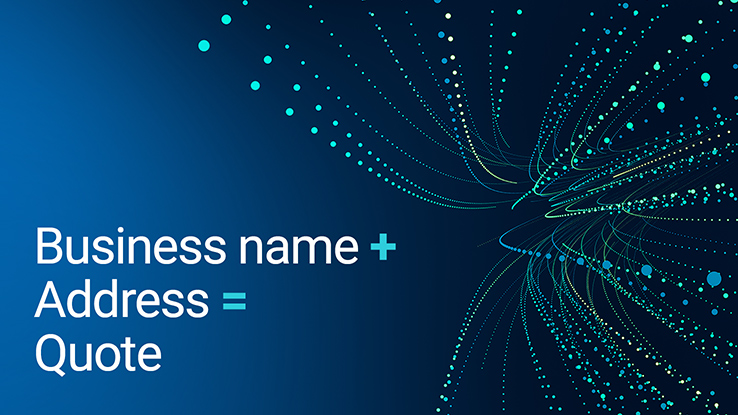
Artificial intelligence (AI) and machine learning (ML) are much in the news these days. But to paraphrase the late computer scientist Edsger Dijkstra, saying a machine is “intelligent” or “learning,” is a bit like saying a submarine knows how to swim. What really matters is that the submarine can move through water.
In that spirit, when we talk about AI/ML in a small commercial insurance environment, what we’re ultimately discussing are powerful analytical tools that can help create new sources of underwriting insight, new workflows, and new value for insurer and insured alike.
So, what can these analytical tools do for small commercial underwriters? Here are four major benefits.
1. New sources of underwriting insight
One of the great advantages of AI/ML is that they can turn previously inaccessible sources of underwriting insights into actionable intelligence. These sources could be words, pixels, videos, audio files, web pages—basically any data that’s not neatly organized into pre-defined fields. This so-called “unstructured data” may be disorganized (at least to a computer), but it’s also filled with potentially useful information that underwriters can use to identify risk exposures, assign NAICS codes, and confirm application details.
A great example is computer vision algorithms, which enable software to identify objects in photos and can scan images posted to social media to identify potential risk exposures.
By identifying those exposures automatically during the underwriting process, the insurer has a better understanding of the applicant’s operations without having to ask intrusive questions or rely on information provided on application (in fact, when this data is provided with a rich suite of traditional underwriting data, they may not need an application at all).
2. New insights from data sources you already use

Insurers often create and maintain their own significant data assets and analyze them to better predict losses or improve other outcomes. AI/ML techniques can provide powerful new ways to analyze this data compared to traditional predictive techniques, such as linear models. That’s because AI/ML techniques excel at analyzing the complex interactions of multiple variables and using these connections to predict outcomes. Traditional modeling may be forced to simplify things to obtain results. Since the real-world is often quite complex, AI/ML models can do a better job at predicting real-world outcomes, which is obviously of great interest to insurers.
These predictions can extend to a number of underwriting functions. For instance, they can be used to help identify coverages an insured may need based on the type of business they operate. They can also be used to recommend appropriate NAICS and SIC codes by comparing an applicant to similar businesses it’s analyzed in the past.
3. Greater consistency
Because they’re working from objective, quantified data, the results produced by AI/ML models can be more consistent than those produced by human underwriters. For example, AI/ML algorithms that apply classifications and recommend coverage options will make predictable decisions every time its confronted with identical data. By contrast, an inexperienced human underwriter may look at the same set of facts differently than a more experienced one and come to a different conclusion.
4. Greater efficiency

Today’s small commercial insurance applications may require long applications that require underwriters to manually verify information—either through web searches or phone calls with agents and/or prospects. Underwriters must then analyze this information to recommend or decline coverage and establish a rate, according to internal guidelines. With the right data, every step of this process can be automated.
As part of a comprehensive dataset that includes traditional sources, AI/ML data can be used to prefill application details using only minimal customer inputs (a business name and address will suffice) as well as identify possible claims and premium-bearing exposures. It can then analyze that information in the context of an industry average for peer businesses to help you understand whether a risk has, say, a higher or lower propensity for claims relative to similar businesses. Based on the information gathered on the applicant, AI/ML algorithms can recommend coverages—just like streaming services serve up one can’t miss cat video after another based on an analysis of your viewing habits.
To learn more about how AI/ML is helping transform small commercial insurance, including the challenges of AI/ML model development and how AI/ML supports underwriting automation, please download our new report, Beyond the buzzword: Understanding the power of AI in small commercial underwriting.
By Tracey Waller and Scott Zrebiec




















 Munich Re Specialty Launches FAIR Plan Commercial Wrap Product in California
Munich Re Specialty Launches FAIR Plan Commercial Wrap Product in California  USAA to Lay Off 220 Employees
USAA to Lay Off 220 Employees  Progressive Gains as Drivers Shop Around for Auto Insurance—Again
Progressive Gains as Drivers Shop Around for Auto Insurance—Again  Fitch: U.S. Cyber Insurers Saw Strong Profits, Slowdown in Premium Growth in 2023
Fitch: U.S. Cyber Insurers Saw Strong Profits, Slowdown in Premium Growth in 2023 